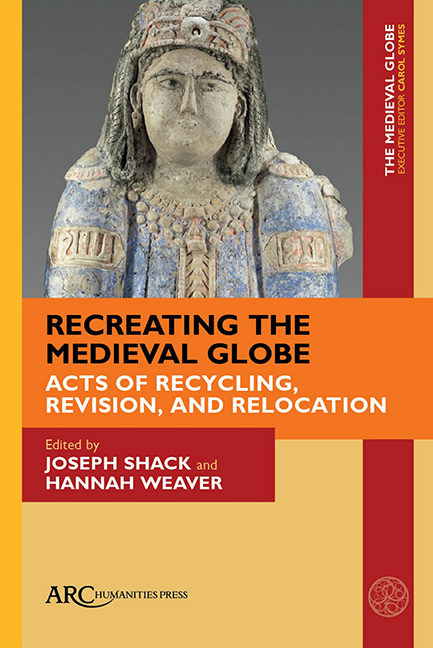Book contents
- Frontmatter
- Contents
- List of Illustrations
- Introduction to Recreating the Medieval Globe: Acts of Recycling, Revision, and Relocation
- Self-Revision and the Arabic Historical Tradition: Identifying Textual Reuse and Reorganization in the Works of al-Balādhurī
- When Curtains Fall: A Shape-Shifting Silk of the Late Abbasid Period
- Salvaging Meaning: The Art of Recycling in Sino-Mongol Quanzhou, ca. 1276–1408
- Recontextualizing Indigenous Knowledge on the Prussian–Lithuanian Frontier, CA. 1380–1410
- Meubles: The Ever Mobile Middle Ages
- Reflection
- Index
When Curtains Fall: A Shape-Shifting Silk of the Late Abbasid Period
Published online by Cambridge University Press: 22 June 2021
- Frontmatter
- Contents
- List of Illustrations
- Introduction to Recreating the Medieval Globe: Acts of Recycling, Revision, and Relocation
- Self-Revision and the Arabic Historical Tradition: Identifying Textual Reuse and Reorganization in the Works of al-Balādhurī
- When Curtains Fall: A Shape-Shifting Silk of the Late Abbasid Period
- Salvaging Meaning: The Art of Recycling in Sino-Mongol Quanzhou, ca. 1276–1408
- Recontextualizing Indigenous Knowledge on the Prussian–Lithuanian Frontier, CA. 1380–1410
- Meubles: The Ever Mobile Middle Ages
- Reflection
- Index
Summary
THE FRAGMENTS OF a steely blue silk “jacket,” now at the Textile Museum in Washington, DC, once bore a woven inscription referring to the Buyid emir of Iraq, Bahāʼ al-Dawlah (r. 988–1012 CE) (Figure 3.1). Originally, it was woven in two registers across the surface of a larger textile. However, the parts of this inscription that specifically identified the emir, as well as his father, were cut away and lost during the eleventh century when the silk was reused and made into this garment, sometime during Seljuk rule in the region (1037–1194 CE). The altered inscription left only the name of a treasurer in Buyid service, for whose use the silk was originally made, along with fragments of Buyid titles. Today, the fragments are displayed in such a manner as to privilege the reading of these Kufic remnants as they would have appeared in the Buyid period, erasing the Seljuk garment through which the text was re-configured to convey a different message (Figure 3.1). As a result, the silk's reconfiguration as a jacket and the earlier textile to which its inscription corresponded are at odds, eliding the Buyid official's proof of authorization and its later reuse in the Seljuk period as a courtly garment. Further intensifying the disconnection between the two is the fact that, in its museum context, the piece is neither a means of extending a ruler's authority to his subordinates, nor is it a tactfully repurposed garment. Rather, the twentieth-century emphasis on the inscription and its denotative value has made the textile into a text: a historical document, and a partial one at that.
The material evidence, however, tells a very different, un-modern story of preservation achieved through alteration, whereby elites of the late Abbasid period (950–1250 CE) maintained both the textile and their social standing when faced with changing political fortunes. In an effort to recover the discarded details—historical and material—of this story, this study follows the silk once bearing the name of Bahāʼ al-Dawlah through the late Abbasid transition from Buyid to Seljuk rule in the eleventh century. It posits that the silk was once an official Buyid curtain (sitr), and that the descendants of the original owner altered it in the eleventh century, under Seljuk rule, in order to highlight their family's prestige while simultaneously disassociating themselves from the politically defunct Buyids.
- Type
- Chapter
- Information
- Recreating the Medieval GlobeActs of Recycling, Revision, and Relocation, pp. 31 - 56Publisher: Amsterdam University PressPrint publication year: 2020

